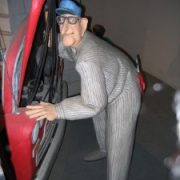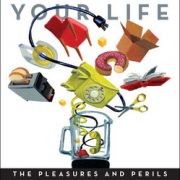Thanks to the Rubin Museum of Art’s curatorial assistant Tracey Friedman for this guest post. Here, Tracey explains what happened when she came to Washington to research medieval cosmology in the Smithsonian’s Dibner Library for their upcoming exhibit, Visions of the Cosmos.

Rubin Museum curatorial assistant Tracey Friedman researches medieval cosmology at the Smithsonian's Dibner Library.
We started with the questions: How did we come to be? What is beyond the earth? How did the universe begin? How has man conceived of his place in the universe throughout history? The human condition is marked by an awareness of a mortal self and a curiosity about the surrounding world, giving rise to certain questions that have been answered by myths, philosophies, and mathematics. The Rubin Museum of Art’s (RMA) upcoming exhibition, Visions of the Cosmos: From the Milky Ocean to an Evolving Universe, will explore the different systems, both religious and scientific, that have developed in Eastern and Western cultures to explain man’s relationship to the universe.
As the curatorial assistant for this exhibition, I was charged with providing the research for the Western portion of the show. I had help from a greatly accomplished astrophysicist in putting together a preliminary list of potential objects, but it wasn’t nearly enough to narrate the Western tale of the cosmos.
We turned to the Smithsonian. As a new Affiliate, we relied on the help of our liaison, Jennifer, to set up the appropriate avenues to research a new subject area. She believed the best outlet to meet our needs was the Dibner Library. I was a bit skeptical because I had never heard of this library and felt the allure of other more well-known Smithsonian museums and research centers. Jennifer sent me a list of relevant books held by the Dibner, available from their online catalog (another great resource for Affiliates). I had a list of remarkable pieces to start with, many of which were housed at the Dibner itself, inside the National Museum of American History. I decided that I needed to see these pieces for myself and find the images that would illustrate our story.
Within two weeks I had an appointment and traveled the four-and-a-half hours to Washington D.C. When I arrived, the staff at the Dibner Library had all of the books I requested, and more, set out for me. To my pleasant surprise, the librarians took my topic and ran with it. I was presented with numerous books dealing with an assortment of corresponding themes that they had extracted from my original list. I was impressed by the effort that had been put into this scholarly search, and thankfully, one of the librarians explained their research strategies and rationale with me upon my arrival. I was then led into the cozy, dimly-lit reading room and sat down with my pile of books for the rest of the day. Each time I reached the maximum limit of books allowed in the room, the pile would rotate out for an equally large stack. I was thumbing through each of the books, making notes and marking pages of interest. Instead of drawing my typical makeshift renderings of the images, the librarian made a copy of the pages I selected. I was elated.
I am so pleased with the final selection of books that we are borrowing from the Dibner for our show. The section of the show I researched will trace how Western medieval anthropocentric cosmology, which envisioned humans at the center of a static universe, was replaced in the Renaissance by a heliocentric universe, giving rise to our present, evolving astrophysical worldview. Among the 6 rare books we borrowed from the Smithsonian are texts ranging from the 10th Р17th centuries, representing great scientists and philosophers such as Galileo, Oronce Fin̩, and Joannes de Sacro Bosco.
My experience made it clear that my institution’s new affiliation with the Smithsonian will be a great tool for us. I hope that my experience inspires other Affiliates to create similar partnerships and take advantage of smaller Smithsonian entities like the Dibner Library.
To read more stories about discoveries and collections at the Smithsonian’s network of 20 libraries, check out their blog and website.














